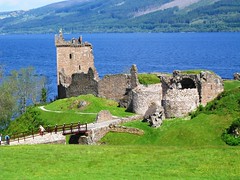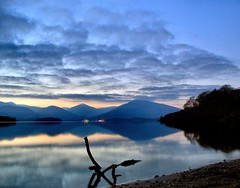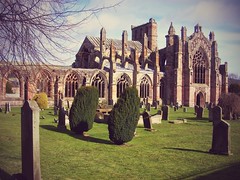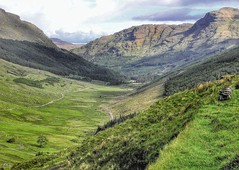House For An Art Lover, Glasgow
continued...Like the hall, the adjacent dining room, in the north side of the building, is a dark space. Not a mere coincidence, rooms on the north entry side of the house tend to be dark. Visitors to the house would progress from dark to light rooms, found on the south side. That’s not to say the northern facing rooms were dull, they are illuminated by touches of colour.
 Bright gesso panels with elegant
female figures divert the eye upwards, whilst
uniquely Mackintosh high-backed chairs and a
dining table stand firmly as a focus in the
centre of the room. Above the central fireplace a
bright mural decoration adds further slashes of
colour and the elegant sideboard is a stunning
example of Mackintosh’s furniture design.
Bright gesso panels with elegant
female figures divert the eye upwards, whilst
uniquely Mackintosh high-backed chairs and a
dining table stand firmly as a focus in the
centre of the room. Above the central fireplace a
bright mural decoration adds further slashes of
colour and the elegant sideboard is a stunning
example of Mackintosh’s furniture design.
Mackintosh’s drawings gave good reference for the design of the furniture and there were also many examples of his chairs in existence, which were used in reference to design House for an Art Lover’s furniture. The chairs and tables were scaled up to suit the House’s dimensions. Coverings were made from woven seagrass, a material that Mackintosh used. Other Mackintosh chairs were consulted to design the features on the House’s chairs.
Mackintosh’s design is about practical well-thought-out rooms. There is a door to the right of the fireplace through which servants would enter to clear the dining room table and at the top right of the room there is another door through which they would leave with the dishes they had cleared from the dining room table.
White walls and delicate colours in the music room create a startling contrast to the darker northern rooms. In 1900 a room like this would have been quite unlike anything previously seen. The heavy use of white was typical of Mackintosh who liked clean lines and interiors, which the music room personifies.
The competition brief was liberating for Mackintosh. A large house, it was designed so that upstairs could be used privately and the main floor for public and entertainment purposes, such as recitals, small dramatic productions and parties. Mackintosh interpreted the competition brief in an unusual manner, liberating himself as an architect and allowing him to create this most dramatic and challenging room.
Despite having so many features and magnificent furniture examples, it has the scale to hold it all comfortably. In any other domestic interior you could never accomplish what Mackintosh managed in the music room. It is the most dramatic and challenging room because of the amount contained within it. The furniture is simple and does not detract from the architectural qualities of the room. Only the lights impose over the space. The lanterns, hung by cords, add to the effect being that of a cluster of perpendicular lines. The dominant feature in the room is the piano; its purpose seems secondary to its ornate decoration.
Running the length of the music room is a balcony, which can be accessed via any of the six ornate double doors. It is easy to picture a suitable scene - a balmy summer’s evening, music coming from the piano through the open doors onto the terrace as guests step out to breathe the night air. A place to gather for a quiet conversation surrounded by the trees and the park.
Completing the tour is the oval room, designed as a drawing room for ladies to retire to after dinner. In keeping with its use, Mackintosh based this room on his favourite feminine symbol, the oval. It is reflected not only in the shape of the room but carries into the detailing of the cabinet, the fireplace and the light fittings. Building this room presented a number of problems not least because it was shown only in plans without a detailed illustration of the proper interior.
The architects working on the house had to carry out months of research to devise detailing and proportions of this room. One building in particular was very important in providing clues. In 1904, Mackintosh created an oval music room for the home of his patron, Kate Cranston, famous in Glasgow for her fashionable tearooms.
The room is no longer in existence as the house was later demolished but photographs remained. From these and other detailed research, the architects were able to create this delicate room which would appeal to even the most sophisticated guest. A room like this was groundbreaking at the turn of the century. Its clean modern lines and light airy atmosphere contrasted sharply with the dark, traditional, often cluttered interiors of many Victorian houses of the same period.
On the opposite side of the corridor a smoking room for men would have existed. Today this is where visitors are treated to a 20-minute introduction to Mackintosh’s House for an Art Lover.
Mackintosh’s brief was to design a house, but the modern builders were also creating a public space. An additional fire escape had to be shoehorned into the east end of the building. But apart from this small change, Mackintosh’s original plans worked very well within today’s regulations.
Mackintosh gave the public a dream that could be built well and accurately, which is a mark of genius.
House for
an Art Lover
Bellahouston Park
10 Dumbreck Road
Glasgow
G41 5BW
Tel: (0141) 353 4770
Fax: (0141) 353 4771
Email: This email address is being protected from spambots. You need JavaScript enabled to view it.
Web site: www.houseforanartlover.co.uk
Mackintosh Exhibition Opening Hours
10 am - 4 pm every day, except Fridays.
Information line: (0141) 353 4449 (telephone
prior to your visit, as times vary).
The Art Lovers’ Cafe is open from 10 am-10
pm every day, except Friday & Sunday, when it
closes at 5 pm.
Admission
(Mackintosh Exhibition only)
Adult £3.50 (concession £2.50).
The Art Lovers’ Season Ticket can be
purchased for £15.00 for which ticket holders
can enjoy a years free entry and discounts in the
Art Lovers’ Shop and Art Lovers’ Cafe.
Back








